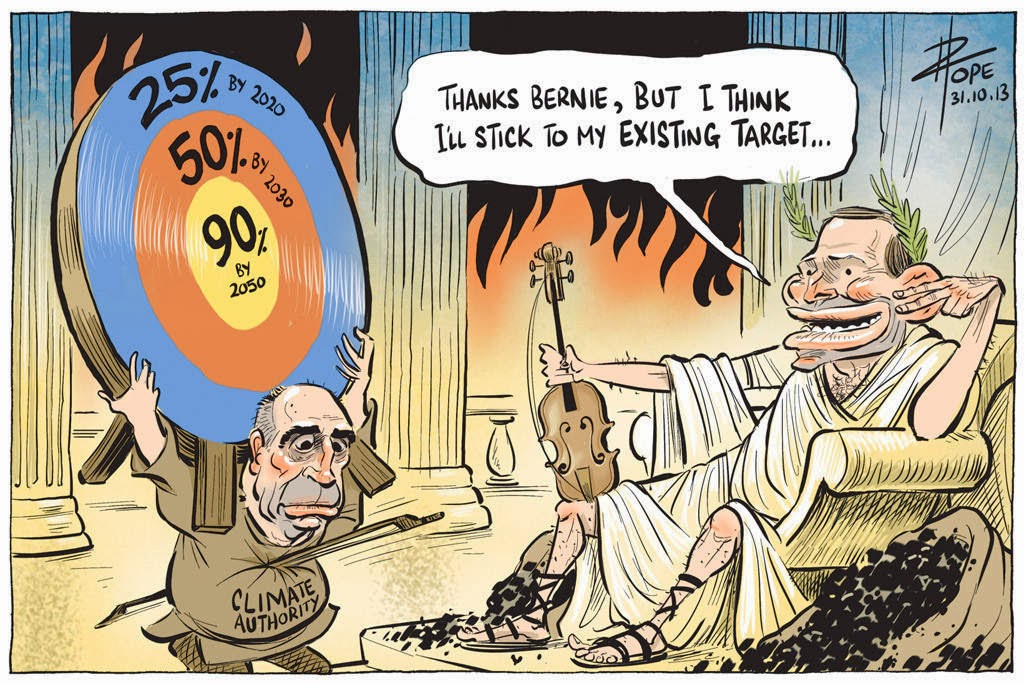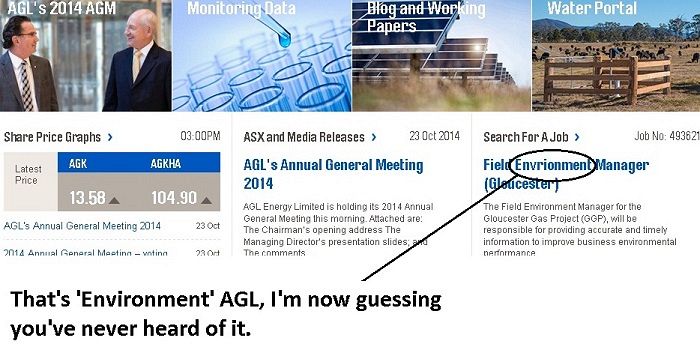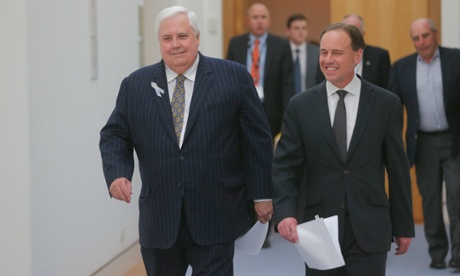Palmer's Climate Lies Should Come As No Surprise
The Abbott government has secured the likely passage of its Direct Action carbon policy through the Senate.
The news comes as a result of an agreement reached yesterday between
Environment Minister Greg Hunt and Palmer United Party leader Clive
Palmer, for the PUP to support the bill with minor amendments.
Once again, after tough talk and media stunts, Palmer has rolled over
in the back rooms and done a deal in his own best interests. As the
owner of several large coal and iron ore mines, Palmer has an obvious
vested interest in ensuring a taxpayer-funded compensation plan for big
polluters.
As we've argued many times,
Direct Action is a fraudulent policy that can’t possibly reduce
Australia’s greenhouse gas emissions to our target of a 5 per cent
reduction by 2020.
What it will do is pay the biggest polluters in the country a total
of $2.55 billion over the next six years. All for doing what everyone
(except the most ardent climate denialists) agrees they must, if the
world is to escape devastating warming: lower their fossil fuel
pollution.
The government claims the policy will spend $2.55 billion in reverse
auctions to those firms that can promise the biggest reductions. This
will be great for the bank balances of big polluters, but won’t do much
to reduce Australia’s overall emissions.
You can get an idea of just how little the government cares by
reference to Hunt’s plans for those polluters who take advantage of the
scheme to rapidly ramp up their emissions. He has no plans to punish
rogue polluters.
Hunt just expects everyone to play by the rules. After all, fining
polluters for releasing greenhouse gases would look awfully like … a
carbon tax. “Our intention is no, our budgeting is no, and that's
because we think the firms will operate within it," Mr Hunt told Sky News on Thursday.
The passing of Direct Action in this manner is Australian politics at its barrel-bottom worst.
Everyone is lying. Hunt is lying when he says Direct Action will
reduce emissions by enough to meet Australia’s 5 per cent target. So
obviously will the policy fall short, the government has understandably
decided not to bother commissioning any fresh modeling.
No credible analyst believes Direct Action can achieve anything like
the 5 per cent emissions reduction target we have signed up to.
According to respected analysts RepuTex, Direct Action may be able to
reduce emissions by 80 to 130 million tonnes at best. “This is
equivalent to a shortfall of over 300 million tonnes for Australia to
meet its 5 per cent emissions reduction target of 421 million tonnes by
2020,” RepuTex’s Hugh Grossman told The Australian.
But even if Direct Action magically achieves the 5 per cent mark, the
next round of international talks will see many countries push
Australia for a bigger reduction by 2030 – perhaps 15 per cent, perhaps
more. There is simply no way Direct Action can do this.
In the manner of chancers everywhere, Hunt has doubled down on his
rhetoric in recent weeks, ramping up the chutzpah to superlative levels.
“Well, this is a scheme which is designed to last for 20 years, for 30
years,” Mr Hunt said in a press conference yesterday. “It is absolutely
capable of providing for the long term.”
Voters might be more confident in such predictions if the government
itself had budgeted for the policy “for the long term.” Direct Action
isn’t even fully budgeted for the medium term: while the headline budget
is $2.55 billion, the forward estimates in Joe Hockey’s May budget provide only $1.15 billion to 2017.
Clive Palmer is lying too. He put out a press release yesterday that
read “Palmer Saves Emissions Trading Scheme”. Even in the
reality-challenged worldview of Palmerama, this is a pretty impressive
confection. Australia doesn’t actually have an emissions trading scheme
to save: Palmer voted with the government to abolish it.
Palmer is probably talking about his pet scheme for a “zero dollar”
emissions trading scheme that would have a carbon price of zero until
Australia’s major trading partners introduce their own schemes
(presumably Europe is not a major trading partner). He secured a token
concession from Hunt on this point, allowing the Climate Change
Authority to research the zero-price ETS and report back.
But Hunt is frank about the government’s attitude to such a proposal.
“We have agreed to a review but our policy is crystal clear, we
abolished the [carbon] tax and we're not bringing it back," Mr Hunt told the ABC this morning.
Palmer is also trumpeting his success in saving certain climate
agencies and initiatives like the Climate Change Authority and the
Australian Renewable Energy Authority, both of which the government
wants to abolish.
It’s not much of a success. The last federal policy that is achieving
any emissions reductions of note, the Renewable Energy Target, is hanging in the balance. Palmer has pledged to vote to keep the RET.
On the other hand, he also pledged to vote against Direct Action,
which he is now voting for. On recent form, anything Clive Palmer rules
out one week is a good chance to receive his support the next. Perhaps
Al Gore can explain.
The real tragedy here – apart from the environmental one – is for
Australia’s future economy. Australia once had a world-leading scheme to
prepare it for a carbon-constrained future. That architecture has been
comprehensively dismantled, to be replaced with government hand-outs to
the worst culprits.
Greens leader Christine Milne made the obvious point. “What we have
here is no contribution to bringing down emissions, no modelling to
backup the claims, by a government and Clive Palmer which tore down an
emissions trading scheme which was bringing down emissions,” she said in
response.
Meanwhile, the world keeps warming, and the world’s economic powers
are rapidly moving towards far more serious efforts to transform their
polluting industries.
If you want proof, look to China’s latest five year plan.
It ploughed billions into renewable energy, established a pilot ETS in
some of the its largest regions, including Beijing, and moved to
radically lower coal consumption in an attempt to curb China’s crippling
air pollution. China has introduced a coal tariff, and Australia’s
biggest trading partner is reportedly preparing to introduce a national ETS in 2016.
In contrast, Australia is going backwards.
Under Direct Action, Australia is storing up huge risks for our
future economic wellbeing. Instead of a gradual transition that allows
the market to adjust in the least costly manner, we are instead headed
for a disruptive future in which rapid decarbonisation may well be
forced on us by international sanction. The result could be precisely
the sort of rust-belt doomsday that Tony Abbott prophesied in his
campaign against the carbon tax.
The news comes as a result of an agreement reached yesterday between
Environment Minister Greg Hunt and Palmer United Party leader Clive
Palmer, for the PUP to support the bill with minor amendments.
Once again, after tough talk and media stunts, Palmer has rolled over
in the back rooms and done a deal in his own best interests. As the
owner of several large coal and iron ore mines, Palmer has an obvious
vested interest in ensuring a taxpayer-funded compensation plan for big
polluters.
As we've argued many times,
Direct Action is a fraudulent policy that can’t possibly reduce
Australia’s greenhouse gas emissions to our target of a 5 per cent
reduction by 2020.
What it will do is pay the biggest polluters in the country a total
of $2.55 billion over the next six years. All for doing what everyone
(except the most ardent climate denialists) agrees they must, if the
world is to escape devastating warming: lower their fossil fuel
pollution.
The government claims the policy will spend $2.55 billion in reverse
auctions to those firms that can promise the biggest reductions. This
will be great for the bank balances of big polluters, but won’t do much
to reduce Australia’s overall emissions.
You can get an idea of just how little the government cares by
reference to Hunt’s plans for those polluters who take advantage of the
scheme to rapidly ramp up their emissions. He has no plans to punish
rogue polluters.
Hunt just expects everyone to play by the rules. After all, fining
polluters for releasing greenhouse gases would look awfully like … a
carbon tax. “Our intention is no, our budgeting is no, and that's
because we think the firms will operate within it," Mr Hunt told Sky News on Thursday.
The passing of Direct Action in this manner is Australian politics at its barrel-bottom worst.
Everyone is lying. Hunt is lying when he says Direct Action will
reduce emissions by enough to meet Australia’s 5 per cent target. So
obviously will the policy fall short, the government has understandably
decided not to bother commissioning any fresh modeling.
No credible analyst believes Direct Action can achieve anything like
the 5 per cent emissions reduction target we have signed up to.
According to respected analysts RepuTex, Direct Action may be able to
reduce emissions by 80 to 130 million tonnes at best. “This is
equivalent to a shortfall of over 300 million tonnes for Australia to
meet its 5 per cent emissions reduction target of 421 million tonnes by
2020,” RepuTex’s Hugh Grossman told The Australian.
But even if Direct Action magically achieves the 5 per cent mark, the
next round of international talks will see many countries push
Australia for a bigger reduction by 2030 – perhaps 15 per cent, perhaps
more. There is simply no way Direct Action can do this.
In the manner of chancers everywhere, Hunt has doubled down on his
rhetoric in recent weeks, ramping up the chutzpah to superlative levels.
“Well, this is a scheme which is designed to last for 20 years, for 30
years,” Mr Hunt said in a press conference yesterday. “It is absolutely
capable of providing for the long term.”
Voters might be more confident in such predictions if the government
itself had budgeted for the policy “for the long term.” Direct Action
isn’t even fully budgeted for the medium term: while the headline budget
is $2.55 billion, the forward estimates in Joe Hockey’s May budget provide only $1.15 billion to 2017.
Clive Palmer is lying too. He put out a press release yesterday that
read “Palmer Saves Emissions Trading Scheme”. Even in the
reality-challenged worldview of Palmerama, this is a pretty impressive
confection. Australia doesn’t actually have an emissions trading scheme
to save: Palmer voted with the government to abolish it.
Palmer is probably talking about his pet scheme for a “zero dollar”
emissions trading scheme that would have a carbon price of zero until
Australia’s major trading partners introduce their own schemes
(presumably Europe is not a major trading partner). He secured a token
concession from Hunt on this point, allowing the Climate Change
Authority to research the zero-price ETS and report back.
But Hunt is frank about the government’s attitude to such a proposal.
“We have agreed to a review but our policy is crystal clear, we
abolished the [carbon] tax and we're not bringing it back," Mr Hunt told the ABC this morning.
Palmer is also trumpeting his success in saving certain climate
agencies and initiatives like the Climate Change Authority and the
Australian Renewable Energy Authority, both of which the government
wants to abolish.
It’s not much of a success. The last federal policy that is achieving
any emissions reductions of note, the Renewable Energy Target, is hanging in the balance. Palmer has pledged to vote to keep the RET.
On the other hand, he also pledged to vote against Direct Action,
which he is now voting for. On recent form, anything Clive Palmer rules
out one week is a good chance to receive his support the next. Perhaps
Al Gore can explain.
The real tragedy here – apart from the environmental one – is for
Australia’s future economy. Australia once had a world-leading scheme to
prepare it for a carbon-constrained future. That architecture has been
comprehensively dismantled, to be replaced with government hand-outs to
the worst culprits.
Greens leader Christine Milne made the obvious point. “What we have
here is no contribution to bringing down emissions, no modelling to
backup the claims, by a government and Clive Palmer which tore down an
emissions trading scheme which was bringing down emissions,” she said in
response.
Meanwhile, the world keeps warming, and the world’s economic powers
are rapidly moving towards far more serious efforts to transform their
polluting industries.
If you want proof, look to China’s latest five year plan.
It ploughed billions into renewable energy, established a pilot ETS in
some of the its largest regions, including Beijing, and moved to
radically lower coal consumption in an attempt to curb China’s crippling
air pollution. China has introduced a coal tariff, and Australia’s
biggest trading partner is reportedly preparing to introduce a national ETS in 2016.
In contrast, Australia is going backwards.
Under Direct Action, Australia is storing up huge risks for our
future economic wellbeing. Instead of a gradual transition that allows
the market to adjust in the least costly manner, we are instead headed
for a disruptive future in which rapid decarbonisation may well be
forced on us by international sanction. The result could be precisely
the sort of rust-belt doomsday that Tony Abbott prophesied in his
campaign against the carbon tax.












